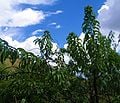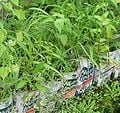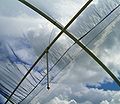m (Standardize wikitext) |
|||
| (16 intermediate revisions by 8 users not shown) | |||
| Line 1: | Line 1: | ||
[[File:100 2078.JPG| thumb | [[File:100 2078.JPG|thumb|Fig.1]] | ||
{{Project data | |||
| location = Oaxaca, Mexico | |||
}} | |||
[[File:100 2175.JPG|thumb|Fig.2]] | |||
[[File:100 2178.JPG|thumb]] | |||
Forests help stabilize soil, prevent [[erosion]] into water ways, and slows water flow from rain so that there is increased time for [[percolation]] into [[aquifers]] as well as offering many other ecosystem services. To regenerate ecosystems it is useful imitate nature: plant native plants - not only trees but also shrubs and herbs - and to encourage natural regeneration in places that are not too damaged. In other highly deteriorated areas Pedregal starts by stabilizing the soil before planting any tree. The reforestation plan includes how to care for the plants as well as how to irrigate them when planting. This is one project in a series of soil conservation, groundwater recharge, and farming demonstration projects at [[Permaculture Demonstration Center in San Andres Huayapam|Pedregal a Permaculture Demonstration Center in San Andres Huayapam]], Mexico. | |||
== Social Aspects of Re-vegetation Planning == | |||
A common error in reforestation programs is that they forget to promote the participation of all possible social groups and the only thing focused on is the planting of trees. This can especially be seen when the planning and planting is done by the military, volunteer groups, or forced labor groups. The consequence of this is that often the plants are injured or improperly planted and are often abandoned later with no monitoring or maintenance. | |||
In reforestation planning it is usually necessary to include at least the 3 following groups: governmental groups (providing money, plants, or labor groups through military or social service), local communities and civil associations involved (in the adoption, planting, and aftercare of plants), and a technical advisory group (to propose the species, time and reforestation techniques).<ref name="Lopez">Lopex, Laura. L., Esteva, Gustavo., Consejo, Juan J., Padilla, Eugenio., Robles, Marcela., and Alejandre, Virginia. Defensa Ecologica: Manual de Tecnicas. 2a. edition. Oaxaca, 1998.</ref> | |||
=== Possibilities to ensure Local Participation in Reforestation & Aftercare === | |||
*Offer conferences, workshops, and courses on sustainable harvesting from the forest and make agreements on sustainable harvesting in exchange for delivering plants for reforestation. | * Delivering plants after an agreement in which the family or community association agrees to care for them. | ||
* Offer conferences, workshops, and courses on sustainable harvesting from the forest and make agreements on sustainable harvesting in exchange for delivering plants for reforestation. | |||
* Delivering fruit trees along with other plants intended to recover the forestland, the fruit trees not only provide soil cover they also give direct benefits to the local community through food, giving more incentive to people to continue to care for plants. | |||
* Grant credits for acquiring or offer to construct wood-saving stoves in exchange for community participation in the transplant and care of trees for wood and fruit production. | |||
* Promotion of saving wood and water and gray water treatment for irrigation of fruit trees and ornamental plants.<ref name="Lopez" /> | |||
== Benefits of Reforestation == | |||
Trees help: | Trees help: | ||
*sustain food resources by reducing erosion and thus preserving the top soil | * sustain food resources by reducing erosion and thus preserving the top soil | ||
*in arid regions, trees also have the ability to raise the water table, as well as preserve the soil moisture and moderate temperatures thus reducing desertification. | * in arid regions, trees also have the ability to raise the water table, as well as preserve the soil moisture and moderate temperatures thus reducing desertification. | ||
*Fruits, nuts, or forest animals attracted to the tree can also make up an important part of our diet | * Fruits, nuts, or forest animals attracted to the tree can also make up an important part of our diet | ||
*Sequestration of Carbon dioxide as the tree transforms carbon in the air into biomass (including leaves, trunk,etc). | * Sequestration of Carbon dioxide as the tree transforms carbon in the air into biomass (including leaves, trunk,etc). | ||
*Preserves habitat for wildlife | * Preserves habitat for wildlife | ||
For more on the benefits of reforestation go to [http://www.plantit2020.org/benefits.html| Plant It] | For more on the benefits of reforestation go to [http://www.plantit2020.org/benefits.html| Plant It] | ||
==Selecting plants== | == Selecting plants == | ||
The selection depends on the objectives, location and availability of plants, among other things. In general it is convenient to use a considerable variety of species, preferably local or at least adapted to the place. | |||
The selection depends on the objectives, location and availability of plants, among other things. In general it is convenient to use a considerable variety of species, preferably local or at least adapted to the place. The use of exotic species such as eucalyptus and casuarina, prevents the restoration of vegetation local to the place and can create environmental problems from its large consumption of water and rapid growth. When choosing plants for reforestation choosing those in relation to each other and the local land is an important aspect of the design. | |||
'''The following is an example of plant species fit for the Central Valleys of Oaxaca:''' | '''The following is an example of plant species fit for the Central Valleys of Oaxaca:''' | ||
==Local trees | == Local trees == | ||
*Above the 275m pine forests dominate naturally. | * At 1600 to 2500m altitude, where the type of vegetation is a forest of oaks. Pedregal has planted local varieties of oaks (Quercus spp), acacia (Acacia spp) and bursera or palo mulato (Bursera bipinnata). | ||
* At 2500 to 2750, where forests of pines and oaks grow, the local trees planted by Pedregal include: teocotes (Pinus spp.), local oaks, strawberry trees (arbutus granulosa), alder (Alnus acuminata) and romerillos (Pseudosuga). | |||
* Above the 275m pine forests dominate naturally. Pedregal has planted pine trees, strawberry trees and alder as well as other inhabitants in their different elevations including: nanche gourd (Malphigia), zompantle (Erythrina), cazahuate (Budleja), poinsettia (Euphorbia), wild guava, acacia (Acacia), May flower (Plumeria), copal (Bursera), plum Creole (Spondias), bald cypress (Taxodium), manual leon (Oreophanax), sweetgum (Liquidambar) cuajilote (Paramenteria), mesquite (Prosopis).<ref name="Lopez" /> | |||
==Local shrubs and succulent plants== | == Local shrubs and succulent plants == | ||
Huizaches, sagebrush, bromeliads, and cacti (organos, nopal, agave, barrel cactus, lettuce cactus, and perezquia). | Huizaches, sagebrush, bromeliads, and cacti (organos, nopal, agave, barrel cactus, lettuce cactus, and perezquia). | ||
== Non-local ornamental plants and fruit == | |||
Avocado, hawthorn, nancy, apple, quince, peach, lemon, orange, fig, mandarin, banana, mango, mamey, coffee, pomegranate, poplar, cassava, jacaranda, paradise, papaya, laurel, and many more have been planted. | |||
Avocado, hawthorn, nancy, apple, quince, peach, lemon, orange, fig, mandarin, banana, mango, mamey, coffee, pomegranate, poplar, cassava, jacaranda, paradise, papaya, laurel, | |||
<gallery> | <gallery> | ||
File:100_2142.JPG| Fruit trees provide food and soil stabilization | File:100_2142.JPG| Fruit trees provide food and soil stabilization | ||
File:100_2133.JPG| Polyculture planting of cactus, fruit trees, and corn. | File:100_2133.JPG| Polyculture planting of cactus, fruit trees, and corn. | ||
File:100_2143.JPG| Local tree species with spines to protect itself | File:100_2143.JPG| Local tree species with spines to protect itself | ||
File:100_2082.JPG| Cactus plant re-vegetation for arid areas | File:100_2082.JPG| Cactus plant re-vegetation for arid areas | ||
| Line 70: | Line 69: | ||
File:100_2187.JPG | File:100_2187.JPG | ||
File:100_2189.JPG | File:100_2189.JPG | ||
File:100_2188.JPG| Nursery full of baby trees and local shrubs. | File:100_2188.JPG| Nursery full of baby trees and local shrubs. | ||
</gallery> | </gallery> | ||
==References== | == References == | ||
<references/> | |||
<references /> | |||
{{Page data | |||
| keywords = Forestry | |||
| sdg = SDG15 Life on land | |||
}} | |||
[[Category: | [[Category:Food and agriculture]] | ||
[[Category:Forestry]] | |||
[[Category: Forestry | |||
Latest revision as of 14:03, 23 October 2023
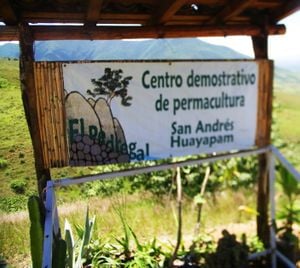
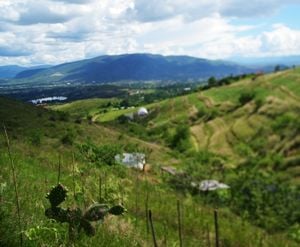
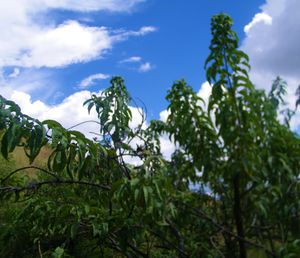
Forests help stabilize soil, prevent erosion into water ways, and slows water flow from rain so that there is increased time for percolation into aquifers as well as offering many other ecosystem services. To regenerate ecosystems it is useful imitate nature: plant native plants - not only trees but also shrubs and herbs - and to encourage natural regeneration in places that are not too damaged. In other highly deteriorated areas Pedregal starts by stabilizing the soil before planting any tree. The reforestation plan includes how to care for the plants as well as how to irrigate them when planting. This is one project in a series of soil conservation, groundwater recharge, and farming demonstration projects at Pedregal a Permaculture Demonstration Center in San Andres Huayapam, Mexico.
Social Aspects of Re-vegetation Planning[edit | edit source]
A common error in reforestation programs is that they forget to promote the participation of all possible social groups and the only thing focused on is the planting of trees. This can especially be seen when the planning and planting is done by the military, volunteer groups, or forced labor groups. The consequence of this is that often the plants are injured or improperly planted and are often abandoned later with no monitoring or maintenance.
In reforestation planning it is usually necessary to include at least the 3 following groups: governmental groups (providing money, plants, or labor groups through military or social service), local communities and civil associations involved (in the adoption, planting, and aftercare of plants), and a technical advisory group (to propose the species, time and reforestation techniques).[1]
Possibilities to ensure Local Participation in Reforestation & Aftercare[edit | edit source]
- Delivering plants after an agreement in which the family or community association agrees to care for them.
- Offer conferences, workshops, and courses on sustainable harvesting from the forest and make agreements on sustainable harvesting in exchange for delivering plants for reforestation.
- Delivering fruit trees along with other plants intended to recover the forestland, the fruit trees not only provide soil cover they also give direct benefits to the local community through food, giving more incentive to people to continue to care for plants.
- Grant credits for acquiring or offer to construct wood-saving stoves in exchange for community participation in the transplant and care of trees for wood and fruit production.
- Promotion of saving wood and water and gray water treatment for irrigation of fruit trees and ornamental plants.[1]
Benefits of Reforestation[edit | edit source]
Trees help:
- sustain food resources by reducing erosion and thus preserving the top soil
- in arid regions, trees also have the ability to raise the water table, as well as preserve the soil moisture and moderate temperatures thus reducing desertification.
- Fruits, nuts, or forest animals attracted to the tree can also make up an important part of our diet
- Sequestration of Carbon dioxide as the tree transforms carbon in the air into biomass (including leaves, trunk,etc).
- Preserves habitat for wildlife
For more on the benefits of reforestation go to Plant It
Selecting plants[edit | edit source]
The selection depends on the objectives, location and availability of plants, among other things. In general it is convenient to use a considerable variety of species, preferably local or at least adapted to the place. The use of exotic species such as eucalyptus and casuarina, prevents the restoration of vegetation local to the place and can create environmental problems from its large consumption of water and rapid growth. When choosing plants for reforestation choosing those in relation to each other and the local land is an important aspect of the design.
The following is an example of plant species fit for the Central Valleys of Oaxaca:
Local trees[edit | edit source]
- At 1600 to 2500m altitude, where the type of vegetation is a forest of oaks. Pedregal has planted local varieties of oaks (Quercus spp), acacia (Acacia spp) and bursera or palo mulato (Bursera bipinnata).
- At 2500 to 2750, where forests of pines and oaks grow, the local trees planted by Pedregal include: teocotes (Pinus spp.), local oaks, strawberry trees (arbutus granulosa), alder (Alnus acuminata) and romerillos (Pseudosuga).
- Above the 275m pine forests dominate naturally. Pedregal has planted pine trees, strawberry trees and alder as well as other inhabitants in their different elevations including: nanche gourd (Malphigia), zompantle (Erythrina), cazahuate (Budleja), poinsettia (Euphorbia), wild guava, acacia (Acacia), May flower (Plumeria), copal (Bursera), plum Creole (Spondias), bald cypress (Taxodium), manual leon (Oreophanax), sweetgum (Liquidambar) cuajilote (Paramenteria), mesquite (Prosopis).[1]
Local shrubs and succulent plants[edit | edit source]
Huizaches, sagebrush, bromeliads, and cacti (organos, nopal, agave, barrel cactus, lettuce cactus, and perezquia).
Non-local ornamental plants and fruit[edit | edit source]
Avocado, hawthorn, nancy, apple, quince, peach, lemon, orange, fig, mandarin, banana, mango, mamey, coffee, pomegranate, poplar, cassava, jacaranda, paradise, papaya, laurel, and many more have been planted.
-
Fruit trees provide food and soil stabilization
-
Polyculture planting of cactus, fruit trees, and corn.
-
Local tree species with spines to protect itself
-
Cactus plant re-vegetation for arid areas
-
-
-
Old tetra pack reused for establishing baby plants.
-
-
-
-
Nursery full of baby trees and local shrubs.





